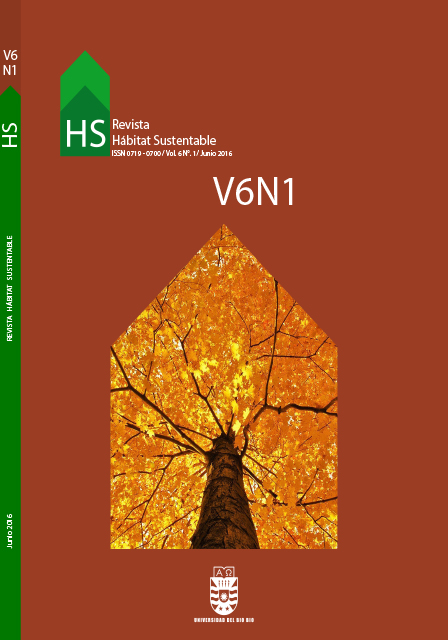Design guidelines to reduce urban temperatures in regions with high solar productivity: Morphological and materials parameters
DOI:
https://doi.org/10.22320/07190700.2016.06.01.09Keywords:
urban design, façades, materials, morphologyAbstract
This study examined the numerical modeling performance of morphological and materials alternatives for reducing urban temperatures. The aim was to identify design and urban regeneration guidelines that enable the densification of residential areas in the city of Mendoza, Argentina. To this end, using ENVI-met 3.1 software 32, scenarios were simulated that combined: different levels of solar reflectance (albedo) of building envelope materials, different urban profile morphologies, the presence or absence of forestation in urban canyons, and E-W/N-S variation in orientation. From the simulation results it can be inferred that there is more efficient thermal performance in the vegetated scenarios that morphologically have a continuous urban profile above the municipal building line. Regarding envelope materiality, there are high albedo levels (0.7) on roofs and pavements, and low albedo levels (0.3) on façades.
Downloads
References
AKBARI, Hashem; LEVINSON, Ronnen y STERNB, Stephanie. Procedure for measuring the solar re ectance of at or curved roo ng assemblies. Solar Energy, 2008, vol. 82, n°7, pp. 648-655.
AKBARI, Hashem; MENON, Surabi y ROSENFELD, Arthur. Global cooling: increasing world-wide urban albedos to offset CO2. Climatic Change, 2009, vol. 94, n°3, pp. 275-286.
ALCHAPAR, Noelia; CORREA, Érica y CANTÓN, M. Alicia. Classi cation of building materials used in the urban envelopes according to their capacity for mitigation of the urban heat island in semiarid zones. Energy and Buildings, 2014, n°69, pp. 22-32.
ALCHAPAR, Noelia y CORREA, Érica. Aging of roof coatings. solar re ectance stability according to their morphological characteristics. Construction and Building Materials, 2015, n°102, pp. 297-305.
ALI-TOUDERT, Fazia y MAYER, Helmut. Numerical study on the effects of aspect ratio and orientation on an urban street canyon on outdoor thermal comfort in hot and dry climate. Building and Environmet, 2006, n°41, pp. 94-108.
BRUSE, Michael. ENVI-met 3.1. On-Line Manual [en línea], 2006. [Consultado 22 mayo 2016] Disponible en: http://www.envi-met. com.
CORREA, Érica. Isla de Calor Urbana. El caso del área metropolitana de Mendoza. Tesis doctoral inédita, Universidad Nacional de Salta, Argentina, 2006.
CORREA, Érica; RUIZ, M. Angélica y CANTÓN M. Alicia. Morfología forestal y confort térmico en “ciudades oasis” de zonas áridas. Ambiente Construido, 2010, vol. 10, n°4, pp. 119 -137.
DOYA, Maxime; BOZONNET, Emmanuel y ALLARD Francis. Experimental measurement of cool facades performance in a dense urban environment. Energy and Buildings, 2012, n° 55, pp. 42-50.
ERELL, Evyatar; PEARLMUTTER, David; BONEH, Daniel y KUTIEL, Pua Bar. Effect of high-albedo materials on pedestrian heat stress in urban canyons. Urban Climate, 2014, n°10, pp. 367-386.
GIVONI, Baruch; Noguchi, MIKIKO; SAARONI, Hadas; POCHTER, Oded; YAACOV, Yaron; FELLER, Noa y BECKER, Stefan. Outdoor comfort research issues. Energy and Buildings, 2003, vol. 35, n°1, pp. 77-86.
JOHANSSON, Erik y EMMANUEL, Rohinton. The in uence of urban design on outdoor thermal comfort in the hot, humid city of Colombo, Sri Lanka. International Journal Biometeorology, 2006, vol. 51, n°2, pp. 119-133.
KOTTEK, Markus; GRIESER, Jürgen; BECK, Christoph; RUDOLF, Bruno y RUBEL, Franz. World Map of the Köppen-Geiger climate classi cation updated. Meteorologische Zeitschrift, 2006, vol. 15, n° 3, pp. 259-263.
PEARLMUTTER, David; BERLINER, P., y SHAVIV, E. Urban climatology in arid regions: current research in the Negev desert. International Journal of Climatology, 2007, vol. 27, n°14, pp.1875- 1885.
SANTAMOURIS, Matheos. Advances in passive cooling (Buildings, energy and solar technology series). Londres: Earthscan Publications Ltd., 2007.
SANTAMOURIS, Matheos. Energy and climate in the urban built environment. New York: Routledge Publications. Taylor & Francis Group, 2011.
SANTAMOURIS Matheos. Cooling the cities - A review of re ective and green roof mitigation technologies to ght heat island and improve comfort in urban environments. Solar Energy, 2014, n°103, pp. 682-703.
SHASHUA-BAR, Limor; TSIROS, Ioannis y HOFFMAN, Milo. Passive cooling design options to ameliorate thermal comfort in urban streets of a Mediterranean climate (Athens) under hot summer conditions. Building and Environment, 2012, n°57, pp.110-119.
SHISHEGAR, Nastaran. The Impact of Green Areas on Mitigating Urban Heat Island Effect: A Review. The International Journal of Environmental Sustainability, 2014, vol. 9, n°1, pp. 119-130.
THORSSON, So a; LINDBERG, Fredrik; BJÖRKLUND, Jesper; HOLMER, Björn yRAYNER, David. Potential changes in outdoor thermal comfort conditions in Gothenburg, Sweden due to climate change: the in uence of urban geometry. International Journal of Climatology, 2010, vol. 31, n°2, pp. 324-335.
YAGHOOBIAN, Neda y KLEISSL, Jan. Effect of re ective pavements on building energy use. Urban Climate, 2012, vol. 2, pp. 25-42.
Downloads
Published
How to Cite
Issue
Section
License
Copyright (c) 2016 Hábitat Sustentable

This work is licensed under a Creative Commons Attribution-ShareAlike 4.0 International License.
The content of articles which are published in each edition of Habitat Sustentable, is the exclusive responsibility of the author(s) and does not necessarily represent the thinking or compromise the opinion of University of the Bio-Bio.
The author(s) conserve their copyright and guarantee to the journal, the right of first publication of their work. This will simultaneously be subject to the Creative Commons Recognition License CC BY-SA, which allows others to share-copy, transform or create new materials from this work for non-commercial purposes, as long as they recognize authorship and the first publication in this journal, and its new creations are under a license with the same terms.











 Scientific Information Program/Concurso Fondos de Publicación de Revistas Científicas 2018/ Proyecto Mejoramiento de Visibilidad de Revistas UBB (Código:FP180007).
Scientific Information Program/Concurso Fondos de Publicación de Revistas Científicas 2018/ Proyecto Mejoramiento de Visibilidad de Revistas UBB (Código:FP180007).





